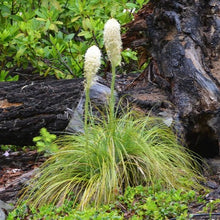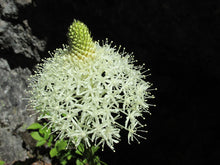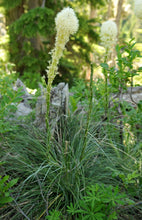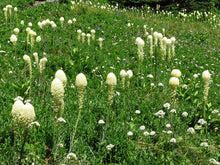
Xerophyllum tenax
Low altitude seed source!
If you've ever been on a mountainous summer hike, in the Pacific Northwest, chances are you've relished at the sight of breath-taking expanses of bear grass in bloom. Bear grass is not actually a grass at all, but rather an evergreen species in the lily family that boasts gorgeous clusters of creamy white flowers on robust stalks that tower above mounds of silver-green, grass-like foliage. It has a plethora of ethnobotanical and wildlife uses and makes a marvelous, albeit slow and moderately difficult to grow, replacement for ornamental grasses. Like one of Dr Suess’ finest characters, this white-tufted beauty is every bit worth the wait and a challenge worth accepting.
- Plant type/canopy layer: evergreen, perennial, herbaceous plant
- Size at maturity: 6-60" tall, 12-48" wide
- Light requirements: full shade, part sun / part shade
- Moisture requirements: moist soil, well-drained
- Bloom Time: May to July
- Growth rate/ease: very slow growth rate, moderately difficult to grow
- Wildlife support: flowers attract and provide nectar to adult butterflies, bees and other insect pollinators; early season fleshy stems are enjoyed by young bears; leaves are also used by bears in winter dens during hibernation; overall plant provides cover, refuge and other wintering habitat for many species of small mammals and insects
- Native habitat/range: grows in a variety of conditions - from rocky alpine slope, mixed-coniferous forest openings, and cool, moist meadows and bogs, in most of western Oregon, Washington and British Columbia, coastal areas of northern and central California, northern Idaho, and small sections of Montana and Wyoming. Portland Plant List - no.
- Special features & uses: drought-tolerant; fire-resistant, requires periodic burns for strong new growth; indigenous peoples traditionally and sustainably use the leaves in weaving and basket-making and ate the toasted roots; it has also been used unethically and irresponsibly by the florist industry in arrangements; landscape uses include meadowscapes, pollinator gardens, rock gardens, woodland garden edges, erosion control and soil stabilization
Gardening with Bear Grass: This slow growing plant can be a bear to grow (get it...a bear?!) but it has been known to thrive, and even bloom, in local gardens. On the surface, it appears to be relatively flexible about growing conditions; it loves to bathe in some sun, but tolerates most any amount of sunlight except deep shade. And although it prefers soils that are moist, it's quite drought-tolerant and appears to thrive in a wide range of soil types - as long as they’re well-draining. Our theory is that the real trick is finding the right combination of ingredients that are going to make the genetics of your specific plant happy. And that, my friends, takes a little luck. Offer it space in your full to partially-sunny rock gardens, meadowscapes or even woodland edges and openings and give it lots of good vibes and you just might get rewarded spectacularly.
Pro tip; try planting it on the shady side of large rocks or woody debris, to help keep the root zone cool and provide supplemental water while it is becoming established and infrequently during particularly hot and dry periods.
Photo Credit 1: "Bear Grass (Xerophyllum tenax)" by Wildreturn is licensed under CC BY 2.0.
Photo Credit 2: "Bear Grass" by Mount Rainier NPS is licensed under CC BY 2.0.
Photo Credit 3: "Xerophyllum tenax (bear grass) flowering" by brewbooks is licensed under CC BY-SA 2.0.
Photo Credit 4: "Bear Grass at Mt. Rainier NP in WA" by Landscapes in The West is marked with Public Domain Mark 1.0.







